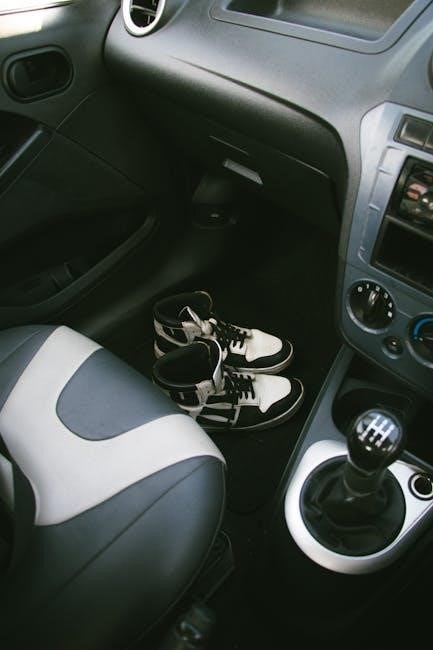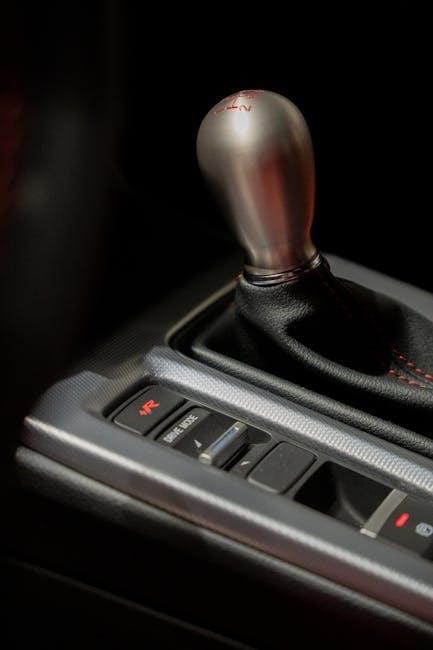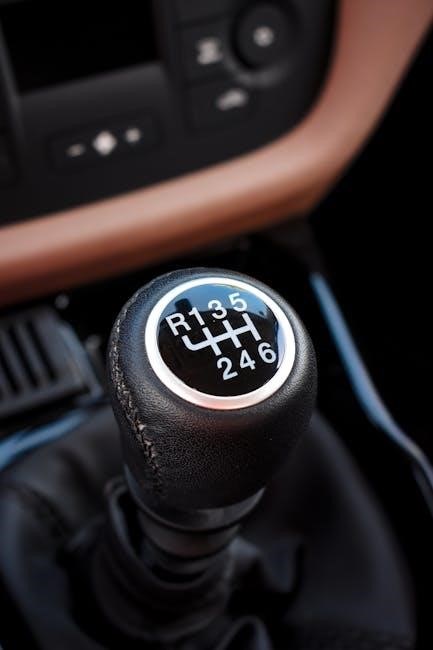A sequential gearbox is a type of manual transmission that offers precise gear control, commonly used in high-performance vehicles. Understanding its operation and maintenance is crucial for drivers and mechanics, as it enhances driving efficiency and ensures optimal performance. This manual provides a comprehensive guide to mastering the sequential gearbox, covering its components, functionality, and troubleshooting techniques.
Definition and Overview of Sequential Gearbox
A sequential gearbox is a type of manual transmission designed for high-performance applications, commonly used in racing and sports vehicles. Unlike traditional manual gearboxes, which use an H-pattern gate, sequential gearboxes feature a simpler mechanism where gears are selected in a linear, sequential order. This design eliminates the need for a clutch pedal in some configurations, allowing for faster and more precise gear shifts. The gearbox typically uses a straightforward gear lever or paddle-shift system, making it ideal for drivers seeking enhanced control and responsiveness. Its compact and lightweight construction also contributes to improved vehicle dynamics and fuel efficiency.
Importance of Understanding Sequential Gearbox Manual

Understanding the sequential gearbox manual is essential for maximizing driving efficiency, performance, and safety. It equips drivers with the knowledge to operate the gearbox effectively, ensuring smooth gear transitions and optimal vehicle control. Proper comprehension of the manual prevents premature wear, reduces maintenance costs, and enhances overall driving experience. For mechanics, it provides insights into troubleshooting and servicing, enabling precise diagnostics and repairs. Mastery of the sequential gearbox manual is crucial for both drivers and technicians, as it promotes better vehicle handling, reduces the risk of component damage, and extends the gearbox’s lifespan. This knowledge is particularly vital in high-performance and racing environments where precision is key.

Basics of Sequential Gearbox Operation
A sequential gearbox operates through manual shifting, engaging gears in a fixed sequence for smooth power delivery. It requires driver input for precise control and performance optimization.
Mechanical Components of a Sequential Gearbox
The sequential gearbox consists of key mechanical components, including gears, gear shafts, and a synchromesh system. The actuator and selector forks enable precise gear engagement. These components work together to ensure smooth, sequential shifting, maintaining optimal power delivery and control.
Understanding Gear Shift Mechanisms

Sequential gearboxes rely on a precise gear shift mechanism to ensure smooth transitions between gears. The process involves the actuator, which engages the desired gear, and selector forks, which move the gear into place. The synchromesh system synchronizes gear speeds, preventing grinding. Drivers use a lever or paddle to initiate shifts, while sensors and hydraulic systems assist in modern models. The mechanism ensures rapid, accurate gear changes, enhancing performance and control. Understanding this process helps drivers optimize shifting techniques and maintain gearbox health. Proper synchronization and timing are critical for seamless operation, making it essential to master the shifting mechanism for optimal vehicle performance.
Role of Clutch and Gear Sync in Sequential Gearbox
The clutch in a sequential gearbox plays a vital role by disconnecting engine power during gear shifts, enabling smooth transitions. In a sequential setup, the clutch is typically a racing-style unit designed for quick engagement. The gear synchronization system, or synchromesh, ensures gears mesh seamlessly by synchronizing their speeds before engagement. This prevents grinding and wear. The clutch pedal’s precise control is essential for effective shifting, while the synchromesh guarantees rapid, accurate gear changes. Together, these components provide the precision and control that define sequential gearboxes. Proper clutch and synchromesh maintenance is critical to avoid incomplete shifts and gear slippage, ensuring optimal performance and longevity.

Types of Sequential Gearboxes
Sequential gearboxes are primarily categorized into manual and automated systems. Manual sequential gearboxes rely on driver input for gear changes, while automated versions use electronic controls for operation.
Manual Sequential Gearbox
A manual sequential gearbox operates solely based on driver input, requiring manual clutch engagement and gear shifts. This setup is popular in racing and high-performance vehicles due to its precise control and quick shifting. Drivers must coordinate clutch pedal presses with gear lever movements, ensuring smooth transitions between gears. The mechanical connection provides direct feedback, enhancing the driving experience. However, it demands skill and practice to master, especially in high-stress racing environments. Regular maintenance, such as clutch and synchro inspections, is essential to maintain optimal performance and longevity. This gearbox type remains a favorite among enthusiasts who value driver engagement and responsiveness.
Automated Sequential Gearbox
An automated sequential gearbox combines the precision of a manual transmission with the convenience of automatic operation. It uses electronic controls and hydraulics to engage and disengage the clutch automatically, eliminating the need for manual clutch pedal input. This design retains the performance benefits of a sequential gearbox while offering ease of use, making it ideal for both everyday driving and high-performance applications. The automated system ensures smooth and quick gear shifts, reducing driver fatigue and enhancing overall efficiency. It is particularly popular in modern sports cars, where it delivers the perfect balance between driver engagement and comfort.

Advantages of Sequential Gearbox
A sequential gearbox offers faster shifting, enhanced driver control, and improved fuel efficiency; Its design minimizes power loss during shifts, providing a more responsive and engaging driving experience.
Faster Gear Shifting and Performance
A sequential gearbox excels in delivering rapid gear shifts, enhancing acceleration and overall vehicle performance. Its direct mechanical engagement eliminates the need for clutch pedal operation in some designs, reducing shift latency. This setup is ideal for racing and high-performance driving, where precise control and quick responses are critical. The sequential design ensures smoother power delivery, maintaining optimal engine RPM during shifts. Advanced systems, such as automated clutches or paddle-shift mechanisms, further accelerate shifting processes. This results in improved lap times and a more engaging driving experience, making it a preferred choice for enthusiasts and professional drivers seeking peak performance and responsiveness.
Improved Driver Control and Precision
A sequential gearbox offers enhanced driver control and precision through its direct mechanical linkage, allowing drivers to feel each gear shift with clarity. This setup minimizes play and provides consistent feedback, crucial for precise control during high-performance driving. The elimination of ambiguity in gear selection ensures smoother transitions, reducing operational delays. Drivers can focus on steering and braking, knowing each shift is deliberate and exact. This level of responsiveness is particularly beneficial in racing or aggressive driving scenarios, where maintaining control and precision is paramount. The sequential design simplifies shifting by eliminating complex gate patterns, further enhancing driver focus and overall vehicle command.
Reduced Driver Fatigue
A sequential gearbox significantly reduces driver fatigue by streamlining the shifting process. The direct mechanical linkage eliminates the need for constant clutch engagement, minimizing physical effort during frequent gear changes. This is particularly beneficial in heavy traffic or during extended drives, where traditional manual transmissions can be tiring. The gearbox’s design ensures consistent and predictable shifts, reducing the mental and physical strain associated with complex gear patterns. Additionally, the absence of a clutch pedal in some sequential systems further simplifies operation, allowing drivers to maintain focus and comfort over long periods. This reduction in effort and complexity makes sequential gearboxes ideal for both performance driving and everyday use.

Limitations of Sequential Gearbox
Sequential gearboxes have higher production costs due to complex engineering and specialized components. Their compatibility is limited to specific vehicles, primarily high-performance or racing cars. Maintenance is intricate, requiring skilled technicians and specialized tools. These factors make sequential gearboxes less accessible for everyday vehicles and budget-conscious drivers.
Higher Cost Compared to Traditional Manual
The sequential gearbox is significantly more expensive than traditional manual transmissions due to its complex engineering and specialized components. The precision manufacturing required for its internal mechanisms, such as the gear shafts and synchronizers, drives up production costs. Additionally, the advanced materials used to withstand high-stress racing or performance conditions further contribute to its premium pricing. This makes sequential gearboxes less accessible for everyday drivers and more suitable for high-performance or racing applications. The higher cost also limits its adoption in budget-friendly vehicles, where traditional manuals remain the economical choice. As a result, sequential gearboxes are typically reserved for niche markets or enthusiasts willing to invest in superior performance.
Limited Compatibility with Vehicles
Sequential gearboxes are designed for specific high-performance or racing applications, making them incompatible with most standard vehicles. Their unique mechanical setup requires precise alignment with the engine and drivetrain, limiting their use to specialized cars. The complex design and high-RPM shifting capabilities make them unsuitable for everyday vehicles, which typically rely on traditional manual or automatic transmissions. Additionally, installing a sequential gearbox often demands custom mounts and modifications, further restricting its compatibility. This exclusivity makes sequential gearboxes less practical for mass-market vehicles and more targeted toward niche automotive segments or racing purposes. As a result, their adoption remains limited compared to conventional transmissions.
Complex Maintenance Requirements
Maintaining a sequential gearbox is inherently complex due to its specialized design and high-precision components. Regular inspections of gears, bearings, and synchros are essential to ensure smooth operation. The gearbox requires specific lubricants, and improper oil changes can lead to premature wear. Additionally, the clutch and gear synchronizers need frequent monitoring and adjustment to prevent slippage or missed shifts. Repairing or replacing worn-out parts often demands specialized tools and expertise, as standard transmission repair techniques may not apply. Furthermore, accessing internal components can be challenging, requiring partial disassembly. Neglecting maintenance can result in costly repairs or complete gearbox failure, making routine servicing crucial for longevity and performance.

Maintenance and Servicing
Regular servicing ensures optimal performance and longevity. Inspect gears, bearings, and synchros, and follow lubrication guidelines. Address worn parts promptly to prevent damage and maintain efficiency.
Regular Inspection of Gearbox Components
Regular inspection of gearbox components is essential for maintaining performance and preventing premature wear. Start by examining gears for signs of wear, pitting, or scoring. Bearings should be checked for smooth rotation and any unusual noise. Inspect synchros for damage or excessive wear, as these are critical for smooth shifting. Additionally, check the clutch and gear engagement surfaces for proper alignment and condition. Lubrication levels and condition should be verified, ensuring the gearbox operates within recommended specifications. Look for any signs of leakage or contamination in the system. Addressing these issues promptly helps prevent costly repairs and ensures optimal gearbox functionality. Regular inspections also provide insight into potential issues before they escalate, promoting long-term reliability and performance.
Oil Change and Lubrication Guidelines
Regular oil changes are critical for maintaining the health and performance of a sequential gearbox. The gearbox oil reduces friction, prevents overheating, and extends component lifespan. Use high-quality, synthetic gearbox oil that meets the manufacturer’s specifications. Change the oil every 30,000 to 60,000 miles, depending on usage and conditions. Before draining, warm up the gearbox by driving for a few minutes to ensure the oil flows freely. Replace the oil filter during each change to prevent contamination. Refill with the recommended oil quantity and type, then check for leaks around the drain plug and filter. Always refer to the manual for specific guidelines tailored to your gearbox model. Proper lubrication ensures smooth operation and prevents premature wear.
Replacing Worn-Out Parts
Replacing worn-out parts in a sequential gearbox is essential to maintain its performance and prevent further damage. Identify components like gears, bearings, and synchros that show signs of wear. Use original equipment manufacturer (OEM) or high-quality aftermarket parts to ensure compatibility and durability. Before replacement, clean the gearbox thoroughly to remove dirt and debris. Follow the manufacturer’s torque specifications when reinstalling components. Lubricate new parts with the recommended gearbox oil to ensure smooth operation; After replacement, test the gearbox by shifting through all gears to confirm proper function. Regularly replacing worn parts extends the gearbox’s lifespan and avoids costly repairs. Always refer to the manual for specific part replacement procedures.

Troubleshooting Common Issues
Identify and address common gearbox problems promptly to ensure smooth operation. Regular checks for unusual noises, vibrations, or slippage help detect issues early. Always follow manual guidelines for inspections and part replacements to maintain optimal performance and longevity.
Diagnosing Gearbox Noise and Vibration
Noise and vibration in a sequential gearbox can indicate worn bearings, faulty gear teeth, or misaligned components. Start by visually inspecting for signs of wear or damage. Use a mechanic’s stethoscope to pinpoint the source of unusual noises. Vibration may stem from imbalanced gears or loose mounts. Check the gearbox oil for contamination or improper levels, as this can exacerbate noise. If issues persist, refer to the manual for specific diagnostic procedures and tolerances. Addressing these problems early prevents further damage and ensures smooth operation. Always replace faulty parts with OEM-compliant components to maintain performance and reliability.
Fixing Gear Slippage and Missed Shifts
Gear slippage and missed shifts in a sequential gearbox often stem from worn synchronizers, clutch pack issues, or incorrect gearbox fluid levels. Start by inspecting the clutch for wear and ensuring proper engagement. Check the gearbox oil level and top it off if necessary. Inspect synchronizer rings for damage and replace them if worn. Adjust or replace the gear lever mechanism if it feels loose or unresponsive. If problems persist, consider rebuilding the gearbox with new components. Always refer to the manual for specific torque settings and adjustment procedures. Addressing these issues promptly prevents further damage and restores smooth shifting performance.
Addressing Clutch Wear and Failure
Clutch wear and failure in a sequential gearbox can lead to poor engagement and slipping between gears. Symptoms include difficulty shifting, a spongy pedal feel, or a grinding noise during gear changes. Inspect the clutch pack for excessive wear or damage and replace it if necessary. Ensure proper alignment during installation and torque the clutch pack bolts to the manufacturer’s specifications. bedding in the new clutch by driving carefully for the first few hundred miles can help ensure proper engagement. Regular inspection of the clutch and surrounding components, such as the release bearing and fork, can prevent premature failure. Addressing these issues early ensures smooth and reliable gear shifts.

Advanced Features of Modern Sequential Gearboxes
Modern sequential gearboxes incorporate advanced features like electronic controls, sensors, and paddle-shift technology, enhancing precision and performance. These innovations improve shifting speed and driver engagement.
Integration with Advanced Driver-Assistance Systems
Modern sequential gearboxes are increasingly integrated with advanced driver-assistance systems (ADAS) to enhance safety and driving efficiency. These systems include features such as adaptive cruise control and automatic emergency braking, which work in harmony with the gearbox to optimize gear shifting based on real-time data. By leveraging sensors and electronic controls, the gearbox can adjust its behavior to suit driving conditions, ensuring smoother transitions and improved fuel efficiency. Additionally, predictive maintenance systems integrated with ADAS can monitor gearbox health, preventing potential issues before they arise. This seamless integration represents a significant leap forward in automotive technology, offering drivers greater convenience and peace of mind.
Use of Sensors and Electronic Controls
Modern sequential gearboxes utilize advanced sensors and electronic controls to optimize performance and efficiency. Sensors monitor gear position, engine speed, and torque, enabling precise control over gear shifts. Electronic controls process real-time data to adjust shifting patterns based on driving conditions, ensuring smooth transitions and maximizing power delivery. These systems also integrate with other vehicle components, such as the engine and brakes, to enhance overall vehicle performance. The use of sensors and electronic controls in sequential gearboxes represents a significant advancement in automotive technology, providing drivers with a more responsive and intuitive driving experience while maintaining reliability and durability.
Paddle-Shift Technology in Sequential Gearboxes
Paddle-shift technology in sequential gearboxes offers a modern, driver-centric approach to gear shifting. Located on the steering wheel, paddle shifters allow drivers to manually change gears without moving their hands from the wheel. This system uses electronic actuators to engage gears, eliminating the need for a traditional gear lever and clutch pedal. Paddle-shift technology enhances driving precision and speed, particularly in high-performance scenarios. It integrates seamlessly with electronic controls, enabling rapid gear changes and improving overall vehicle responsiveness. This innovation combines the convenience of automatic shifting with the control of a manual gearbox, making it a popular choice for modern drivers seeking an engaging yet efficient driving experience.
The sequential gearbox continues to evolve, offering enhanced performance and efficiency. Future trends include advanced electronic integration and innovative materials, ensuring optimal driving experiences for years to come.
Evolution of Sequential Gearbox Technology
The sequential gearbox has undergone significant advancements since its inception, driven by the demand for higher performance and efficiency. Early designs were mechanical, focusing on durability and simplicity, but modern iterations now incorporate advanced electronics and automation. Over the years, manufacturers have refined materials and gear-cutting techniques, reducing weight while improving strength and reliability. The integration of sensors and electronic controls has enabled smoother shifting and adaptive systems, enhancing driver experience. These innovations have positioned sequential gearboxes as a cornerstone of high-performance vehicles, blending tradition with cutting-edge technology to meet the evolving needs of drivers and industries.
Future Developments in Gearbox Design
Future sequential gearboxes are expected to integrate advanced automation and hybrid systems, combining manual control with automatic efficiency. Lightweight materials and modular designs will reduce weight and enhance customization. Integration of AI and predictive software will optimize shifting patterns and adapt to driving conditions. Sustainability will drive the adoption of eco-friendly lubricants and energy-efficient designs. These innovations aim to balance performance, efficiency, and driver engagement, ensuring sequential gearboxes remain relevant in the evolving automotive landscape.
